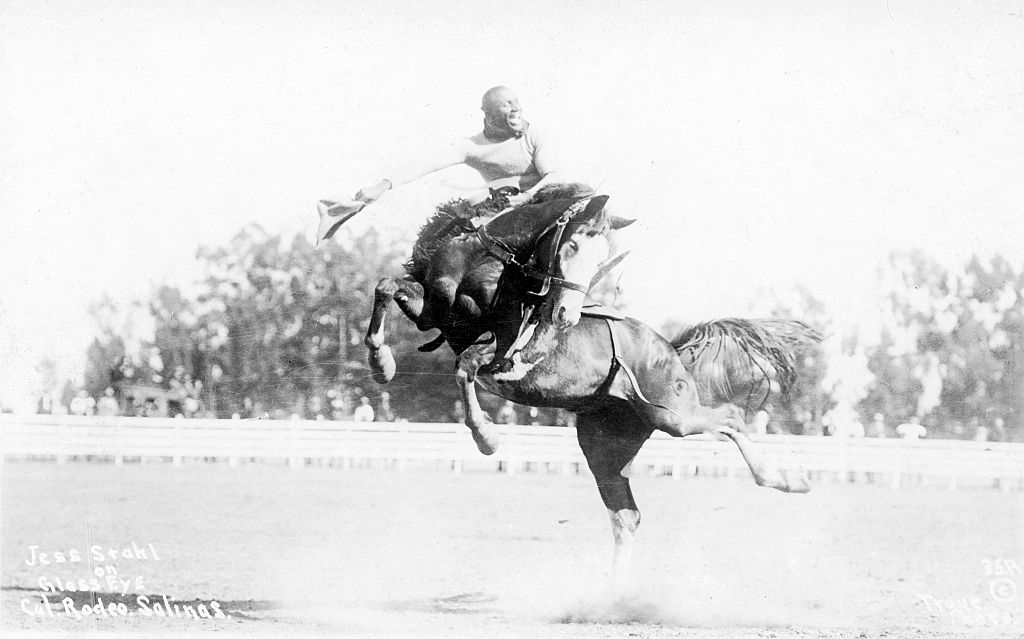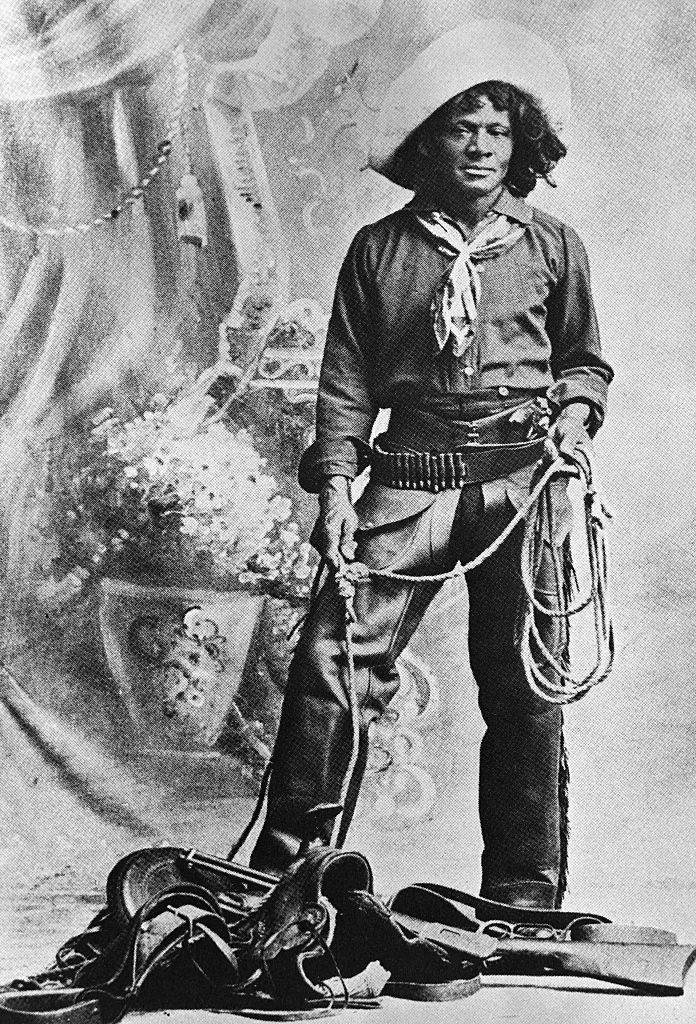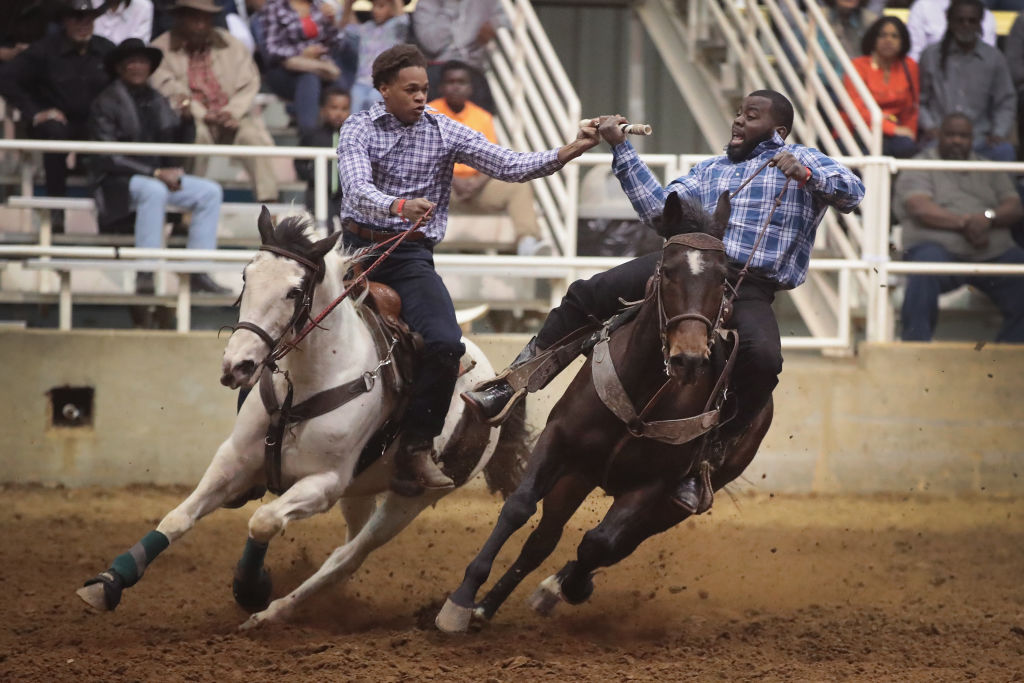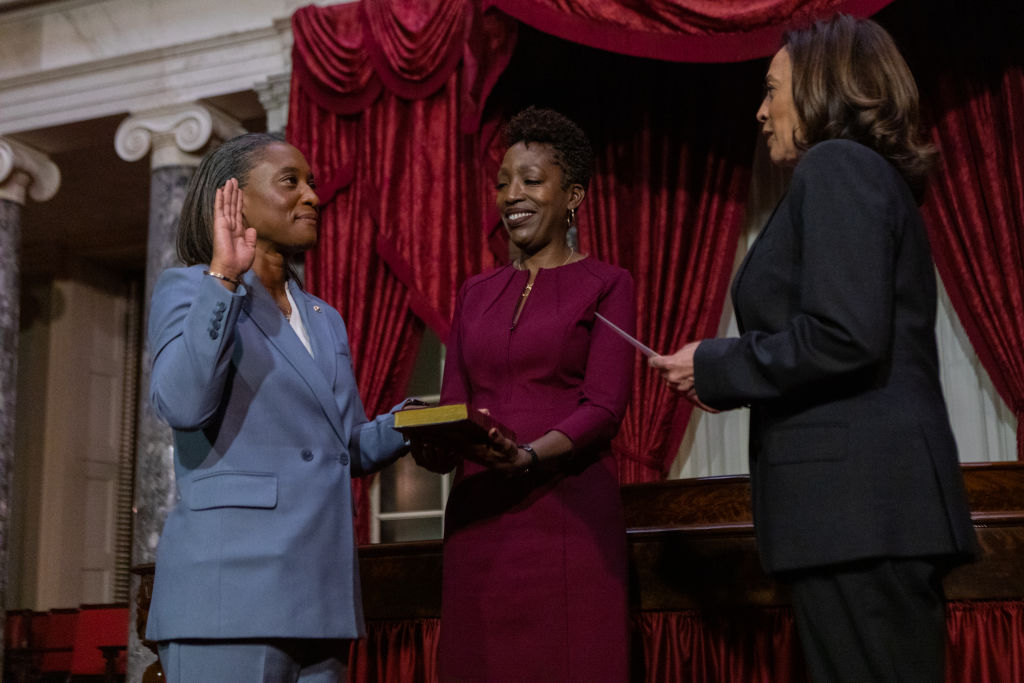The History Of Black Cowboys: America’s First Heroes Of The Western Frontier

Source: JHU Sheridan Libraries/Gado / Getty
The Black Cowboy is as American as Baseball and apple pie but forgotten like tears in the rain.
When America was just a baby, there was a time when expanding out west meant adventure, glory and riches. But within that narrative lies a story often overshadowed by the dust and haze of history. That is the story of the Black cowboys.
As America was finding its footing in the mid-1800s, Black men and women rode atop horses, drove cattle, and helped shape the very fabric of American identity.
In this article, CassiusLife takes a trip through time to explore the extraordinary saga of the Black cowboy, a tale rich in triumphs, challenges and enduring legacies.
The contributions of Black cowboys and their cultural significance to America have been often overlooked, but their influence on shaping the landscape of the Western frontier can not be trivialized.
The Origins
The origins of Black cowboys are hard to pinpoint, but according to BlackPast, the earliest evidence of Black people as cattle herders dates back to colonial South Carolina. Slaves were brought to the early colony from what is now Senegal in West Africa, specifically for their unique skill sets.
By the 1850s, the cattle industry was booming and enslaved Blacks who worked it began migrating across the South to Texas where slaves accounted for nearly 25% of the settler population.
In 1860, Texas had a total of 182,566 enslaved African Americans and only 355 free African Americans, according to the Census. But, by the late 1800s, Texas had become the center of the cattle frontier industry, with several occupations in the industry, including “cattle dealers,” “wild horse catchers,” “horse dealers,” “harness makers” and “herdsmen.”
Because there were so many enslaved Black Americans in Texas, many of them were forced to work on their slave masters’ cattle on their ranches.
The enslaved Black cowboys were responsible for catching and tending wild cattle while keeping up the master’s ranch.
Then came the Civil War in 1865.
Although Texas didn’t officially join the Confederacy until 1861, and the Civil War barely touched Texas soil, white Texans still joined forces with their fellow Confederates to push back against Union forces.
While the slavemasters fought in the war, they relied on their slaves to maintain the cattle and the ranches. This not only allowed enslaved cowboys to hone their skills of cattle tending, but it also allowed them to connect with other American cowboys. According to historians, Black cowboys were taught the cowboy way of life by vaqueros, who were Mexican or Spanish cowboys. Vaqueros were the original cowboys of the American West and their skills also transformed the cattle industry, especially in California. Black cowboys were also introduced to Native American cowboys who also helped them further their skills.
Ranch life wasn’t easy. Although Black cowboys had become well-versed in the way of the ranch, a combination of lack of effective containment and too few cowhands caused cattle to run wild all across the Western frontier. When slave masters returned from the war, their herds were lost or out of control. As the war came to an end, and slave labor was no more, ranchers were forced to hire now-free and highly skilled Black people to wrangle their lost herds. The Black cowboy was officially born and quickly became one of the most popular professions for former slaves.
“Right after the Civil War, being a cowboy was one of the few jobs open to men of color who wanted to not serve as elevator operators or delivery boys or other similar occupations,” William Loren Katz, a scholar of African American history, told the Smithsonian.

Source: Bettmann / Getty
Trailblazers of the West
By the 1900s, America’s appetite for beef skyrocketed and due to the lack of railroads, the demand for Black cowboys also skyrocketed. Ranchers began selling their livestock, which meant enormous herds of cattle needed to be physically moved all across the country. This was a very dangerous job as Black cowboys traversed America’s harsh plains with no roads and Native Americans poised to defend their land.
Still, in a white man’s America, Black cowboys faced immense discrimination in the small towns they passed through. They couldn’t stay at certain hotels or eat in certain saloons, but it didn’t stop them from doing their jobs as they moved across the West, working in every state from Arizona to California to Nevada, and even New Mexico.
Contributions of Black Cowboys to the Cattle Industry
One of the most famous Black cowboys of the Old West was Nat Love.
Nat Love wasn’t your typical cowherd. He was also a writer during a period when most former slaves could barely read. According to Annenberg Learning, Nat Love, who was born a slave in Tennessee, was responsible for driving herds of cattle from the western ranches to the northern stockyards over hundreds of miles of arduous terrain. He was known to spend months at a time on the trail, flexing his survival skills and his mastery of cattle-driving techniques.
His skills of horse riding and roping livestock earned him the nickname “Deadwood Dick,” as his lore grew bigger and bigger.
In 1907, Love released an autobiography titled, The Life and Adventures of Nat Love Better Known in the Cattle Country as “Deadwood Dick.”
In the book, Love tells of his tales as a cowboy, romanticizing the arduous life of a Black cowboy creating a life during the Wild Wild West, which includes the time he was captured by a band of Pima Indians, his 14 bullet wounds throughout his career, and how he met and fell in love with the daughter of a Native American chief.
“The name of Deadwood Dick was given to me by the people of Deadwood, South Dakota, July 4, 1876, after I had proven myself worthy to carry it, and after I had defeated all comers in riding, roping, and shooting, and I have always carried the name with honor since that time.” – The Life and Adventures of Nat Love.

Source: Scott Olson / Getty
Black Cowboys And American Culture
Over decades, television and film have created a false narrative that Cowboys were only heroic white men who fought Native Americans, but this is far from the truth. For example, did you know the popular cowboy anthem, “Home on the Range,” was first recorded by a Black saloon keeper and former cowboy in San Antonio?
The legacy of Nat Love and Black cowboys alike still lives on throughout American culture. In the 2021 Netflix western film, The Harder They Fall, Jonathan Majors plays a rendition of Love, which gave us a sneak peek into what it meant to be a Black cowboy during the Western frontier.
But Black cowboys aren’t only on the big screen, they are also still a part of our everyday life.
From the Houston Rodeo to the streets of Philadelphia, Black cowboys are still here.
I’ll say it again for the folks who didn’t hear me the first time; Black cowboys are as American as Baseball and apple pie, but let’s not forget them like tears in the rain.
SEE ALSO:
Black Folklore In Video Season 2 Ep 8: The Brothers Of Pine Oak
The Black Seminoles: How Fugitive Slaves Escaped To Mexico Before The Civil War
The post The History Of Black Cowboys: America’s First Heroes Of The Western Frontier appeared first on NewsOne.





